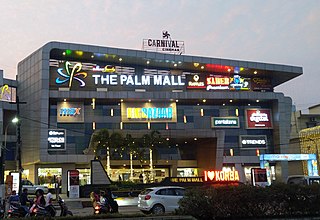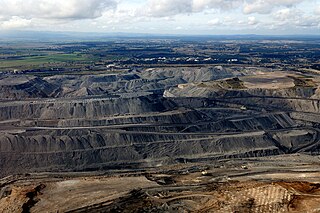
Chhattisgarh is a landlocked state in Central India. It is the ninth largest state by area, and with a population of roughly 30 million, the seventeenth most populous. It borders seven states – Uttar Pradesh to the north, Madhya Pradesh to the northwest, Maharashtra to the southwest, Jharkhand to the northeast, Odisha to the east, Andhra Pradesh and Telangana to the south. Formerly a part of Madhya Pradesh, it was granted statehood on 1 November 2000 with Raipur as the designated state capital.

Korba is a city and an industrial area in Korba District in the Indian state of Chhattisgarh. Korba was part of Bilaspur District before 25 May 1998. It was later designated as a separate district for ease of administration, but is still under Bilaspur Division. Korba is called power hub of India due to its Coal reserves and Industrial base for multiple thermal based power plants from Public sector like NTPC Limited, CSEB from State of Chhattisgarh as well as from private sector apart from Power plants Korba has the Asia's second largest and India's largest open cast coal mine in Gevra area of Korba Coalfield. Korba produces 140 Million tons of coal every year which accounts for 17% of Country's total coal production and 85% of Chhattisgarh Coal production. BALCO Private owned Aluminium producer has its smelter Aluminium Plant in Korba. Here mainly the protected tribal tribe Korwa resides. Korba district is blessed by lush green forests from all around, a large population of tribals is found here. The tribals here prefer to live in harmony with the environment in the forest area due to which they have retained their distinctive cultural characteristics and traditional practices.

Korba District is an administrative district of Chhattisgarh state in central India. The headquarter of this district is Korba.
The Morupule Colliery is a coal mine located in Palapye, Botswana, owned and operated by Debswana, a partnership between the government of Botswana and De Beers. The coalfield is composed of four main seams, only one of which, the No. 1 Seam, is currently being mined, using bord and pillar mining methods.

Chirmiri is a hill station city and a Municipal Corporation in the Manendragarh-Chirmiri-Bharatpur district in the Indian state of Chhattisgarh. It was a part of Koriya district until 15 August 2021 when the separate Manendragarh-Chirmiri-Bharatpur district was created. It is famously known for its coal extraction as the area is rich in coal.

Coal is mined in every state of Australia. The largest black coal resources occur in Queensland and New South Wales. About 70% of coal mined in Australia is exported, mostly to eastern Asia, and of the balance most is used in electricity generation. In 2019-20 Australia exported 390 Mt of coal and was the world's largest exporter of metallurgical coal and second largest exporter of thermal coal. While only employing 50,000 mining jobs nationally coal provides a rich revenue stream for governments.
Coal mining regions are significant resource extraction industries in many parts of the world. They provide a large amount of the fossil fuel energy in the world economy.

Coal in India has been mined since 1774, and India is the second largest producer and consumer of coal after China, mining 777.31 million metric tons in FY 2022. Around 30% of coal is imported. Due to demand, supply mismatch and poor quality with high ash content, India imports coking coal to meet the shortage of domestic supply. Dhanbad, the largest coal producing city, has been called the coal capital of India. State-owned Coal India had a monopoly on coal mining between its nationalisation in 1973 and 2018.

Hasdeo River is the largest tributary of Mahanadi River. The river flows in the state of Chhattisgarh. It joins Mahanadi River near Shiladehi (Birra). Hasdeo Bango Dam is constructed across this river. The river originates about 910.0 m above sea level, in a place about 10.0 km from Sonhat in Koriya district. The total length of the river is 333.0 km, and drainage area is 9856 km2. The major tributary of Hasdeo River is Gej River. The river flows through the Hasdeo Arand forest.
South Eastern Coalfields Limited (SECL) is the largest coal producing company of India. It is a "Miniratna" Company, and one of eight fully owned subsidiaries of Coal India Limited. The company has its headquarter at Bilaspur, Chhattisgarh, India and 92 mines spread over Chhattisgarh & Madhya Pradesh; 70 underground, 21 opencast, and 1 mixed. It is a schedule 'B' Mini Ratna CPSE in coal & lignite under the administrative control of the Ministry of Coal.

Singrauli Coalfield is spread across the districts of Singrauli and Sonebhadra in the Indian states of Madhya Pradesh and Uttar Pradesh, mostly in the basin of the Son River.
Korba Coalfield is located in Korba district in the Indian state of Chhattisgarh in the basin of the Hasdeo River, a tributary of the Mahanadi.
Sohagpur Coalfield is located in Shahdol district in the Indian state of Madhya Pradesh in the basin of the Son River. It is the biggest coalfield in the state of Madhya Pradesh.
Umaria Coalfield is located in Umaria district in the Indian state of Madhya Pradesh in the valley of the Umrer River, a tributary of the Son River.

Adani Enterprises Limited (AEL) is an Indian multinational publicly-listed holding company and a part of Adani Group. It is headquartered in Ahmedabad and primarily involved in mining and trading of coal and iron ore. Through its various subsidiaries, it also has business interests in airport operations, edible oils, road, rail and water infrastructure, data centers, and solar manufacturing, among others.

The Tatanagar–Bilaspur section is part of the Howrah–Nagpur–Mumbai line and connects Tatanagar in the Indian state of Jharkhand and Bilaspur in Chhattisgarh. Part of one of the major trunk lines in the country, it passes through an industrial-mining area and handles high volumes of freight, particularly coal and iron ore.
The Rajmahal Coalfield is a large coalfield located in Jharkhand in eastern India.
Raikheda Thermal Power Station is a coal-based thermal power plant located in Raikheda village in Tilda Tehsil in Raipur district in the Indian state of Chhattisgarh.
Rajhara Area is one of the operational areas of the Central Coalfields Limited located in the Palamu and Latehar districts in the state of Jharkhand, India.
Piparwar Area is one of the operational areas of the Central Coalfields Limited located mainly in the Chatra district and marginally in the Ranchi district in the state of Jharkhand, India.










